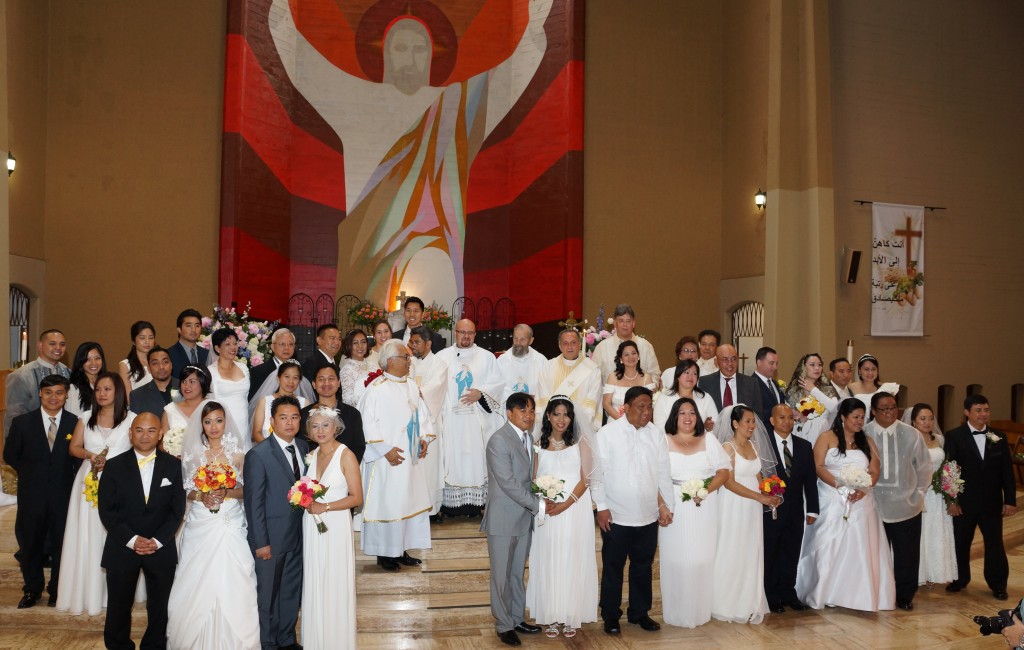
Mostly Filipino couples from several San Francisco Bay Area cities join free mass wedding at St. Thomas More Church. CONTRIBUTED PHOTO
SAN FRANCISCO, California — Saint Thomas More (STM) Catholic Church here last Saturday played host to some 20 couples at a mass wedding, the fourth one since 2011.
The parish-initiated project “Operation: I Do” welcomed the mostly Filipino couples from the different Bay Area cities of Cupertino, Campbell, San Jose, Mountain View, Tracy, Vallejo, San Francisco and Daly City.
Lovely brides and dashing grooms walked the center aisle of the church to exchange marital vows that solemnized their union in accordance with the Sacrament of Marriage.
All but one couple were all previously civilly married, the longest at 34 years, and most of them already have children who became their ring bearers and flower girls. Three brides were pregnant, two of them scheduled to give birth in a month or two.
Some couples even have grown up sons or daughters who gave away the bride during their wedding march to meet the groom at the altar.
Response to alarming news
A brainchild of Filipino parishioner Joe Espinueva, Operation: I Do was the STM church’s response to an alarming 2011 San Francisco Catholic newspaper article that reported of a sharp decline of 47 percent in Catholic marriages.
“Since 2011, we have attracted almost a hundred couples, or an average of 25 couples per year, from different walks of life to finally avail of the Sacrament of Matrimony,” Espinueva told INQUIRER.net.
“For this year, we have nurses, postal workers, administrative assistants and some from the computer field with a bride as young as 28 years old to a groom as old as 66 years old joining us. Most of the couples are both Filipinos with three Filipinas choosing non-Catholic grooms who are also non-Filipinos,” Espinueva added.
As in previous years, the project was fully supported by the priests and deacons, the members of various religious organizations such as the Bukas Loob sa Diyos (BLD), Couples for Christ (CFC), Brotherhood of Christian Businessmen & Professionals (BCBP) and Legion of Mary, among others. More importantly, Pastor Msgr. Labib Kobti readily gave his approval for the project when it was first presented to him.
Too busy with careers
Asked for the reasons why couples do not avail of the benefit of church marriage, Espinueva disclosed that most of the couples were so busy with their careers that they decided getting married in the church could wait and thus placed it on the back burner.
Some regarded the six-month rigorous multiple seminars, on top of their very busy work schedule, household chores and kids’ school activities and sports, as too difficult for them to attend the required meetings. Couples are required to attend at least four meetings of one hour each, once a month as preparation for marriage.
Not the least of the reasons is the high cost of getting married in the church that would compete with payments for education, daily expenses, monthly bills and miscellaneous costs.
“We want to help couples get married in church in a less stressful manner by making the process and faster for them,” explained Espinueva. Thus the Church shoulders the cost of the wedding itself.
Shouldered by the Church
“The church does not charge a single penny,” Espinueva said. “Even the beautiful sounding choir also volunteered their time and their lovely voices. The food were all donated by people with kind hearts, some were cooked by a chef. Some ‘alumni’ couples, realizing how much money they had saved through this project gave donations as well.”
Even as the core group of the project regarded this year’s mass wedding as much-improved and smoother sailing, Espinueva admitted the perennial problem remains in the timely submission of important documents to conform to the Canon Law.
Unfazed, the project’s volunteers go as far as calling the parishes in the Philippines and the National Statistics Office to get hold of existing baptismal, confirmation and even annulment/separation papers from as far as Zamboanga, to help obtain the necessary papers for the wedding.
A major achievement of the project this year, Espinueva said, was saving the marriage of a couple who were in the process of getting a divorce.
On edge of divorce
“The wife had filed (for) a divorce months earlier and their first court hearing was supposed to be last August 6th. Weeks before their case was heard, however, they came across an announcement and learned about the Operation I Do scheduled mass wedding,” Espinueva recalled.
“They then sat down and discussed giving their relationship another chance by getting married in church this time around rather than push through with the divorce. The wife subsequently withdrew the divorce papers she earlier filed and they proceeded to make arrangements to join the mass wedding,” beamed Espinueva.
“At the ceremony itself, they were both in tears when they recited their marriage vows. They kept repeating that Operation I Do saved their marriage and their family,” he said proudly.
As for his message to the newlywed couples, Espinueva advised that they give time for each other as one important reason couples file for divorce is the lack of quality time and undivided attention for one another.
“Time and again, we also mentioned in the seminars that getting married in church doesn’t mean they will never have any more problems,” said Espinueva.
“The difference this time after getting married in the church, however, is that when problem arises, the way they solve/tackle them will be based on the teachings of Jesus, not degenerate to just a mere shouting match. Respect for each other and going to church as a family every Sunday are also very important for them.”
Espinueva attributed the success of the project to the whole Core Group of Operation I Do and the volunteers who gave everything–time, effort, financial help, patience and humility–as service to the couples.
RELATED STORY
San Francisco church offers Catholic wedding – for free

